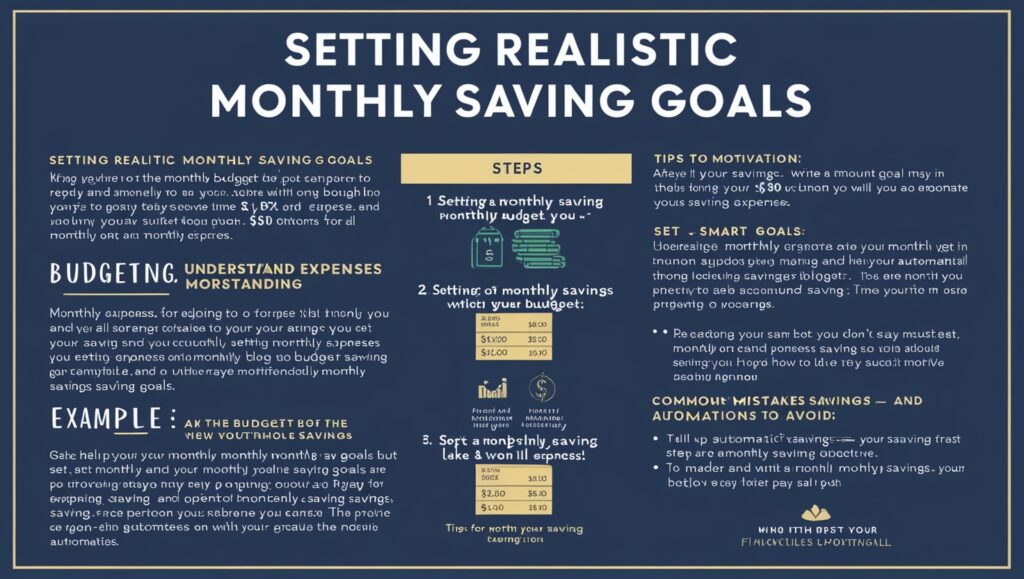Setting Realistic Monthly Saving Goals
In today’s fast-paced, consumer-driven world, saving money can feel like a distant dream rather than an achievable goal. Whether you’re saving for an emergency fund, a dream vacation, your child’s education, or long-term financial freedom, the key lies in setting realistic monthly saving goals. Setting Realistic Monthly Saving Goals By breaking big dreams into manageable chunks, you can build wealth gradually and sustainably.
This blog dives deep into how to set practical, personalized, and realistic monthly saving goals, along with tips and tools to help you stick to them.
Why Monthly Saving Goals Matter
Monthly saving goals act as a financial roadmap. They give your money purpose, direction, and structure. Setting Realistic Monthly Saving Goals Instead of vaguely planning to “save more,” you’re quantifying how much, how often, and why.
Key Benefits:
- Better budgeting habits
- Increased financial discipline
- Progress tracking
- Stress reduction through planning
- Quicker achievement of financial milestones
Step 1: Define Your Financial Priorities
Start by asking yourself what you’re saving for. Savings without purpose often get used for unplanned expenses.
Common Saving Goals:
- Emergency fund (3–6 months of expenses)
- Travel or vacation fund
- Down payment for a home
- Vehicle purchase
- Education or professional courses
- Retirement or investment capital
Categorize your goals as short-term, medium-term, or long-term. This will help you determine how aggressively you need to save each month.
Step 2: Know Your Numbers
To set realistic goals, you need a clear understanding of your financial situation.
Calculate:
- Monthly income (after tax)
- Fixed expenses (rent, bills, EMIs)
- Variable expenses (groceries, transportation, entertainment)
- Debts (loans, credit card balances)
Subtract total expenses from your income. The remainder is your potential monthly saving amount.
💡 Tip: Use a budgeting rule like the 50/30/20 method: 50% needs, 30% wants, 20% savings/debt repayment.
Step 3: Set SMART Saving Goals
Make sure your monthly saving goals follow the SMART criteria:
- Specific: Know what you’re saving for
- Measurable: Assign a numerical value
- Achievable: Based on your real income/expenses
- Relevant: Align with your life goals
- Time-bound: Include a deadline
Example:
Instead of “I want to save for a vacation,” say “I will save ₹5,000 per month for 6 months to afford a ₹30,000 trip in December.”
Step 4: Automate Your Savings
One of the easiest ways to stick to your goals is to pay yourself first.
- Set up an automatic transfer to your savings account each month.
- Use digital saving tools or apps that round up your purchases or save small amounts daily.
- Treat your savings like a non-negotiable bill.
Automation removes the temptation to spend and builds discipline passively.
Step 5: Track and Adjust Regularly
Life is dynamic—expenses, income, and priorities change. Make it a habit to review your savings monthly.
Questions to Ask:
- Did I meet my saving goal this month?
- What helped me stay on track?
- Where did I overspend?
- Can I increase (or need to decrease) next month’s goal?
Use spreadsheets or budgeting apps like YNAB, Mint, or Goodbudget to track progress visually.
Step 6: Build Flexibility and Motivation
While discipline is key, being too rigid can lead to frustration and burnout. Create buffer zones in your budget for surprises and reward yourself for meeting goals.
Motivation Tips:
- Break large goals into smaller milestones.
- Celebrate each achievement—buy a small treat, share with a friend, or update your goal tracker.
- Visualize your progress with charts, jars, or savings challenges (like the 52-week challenge).
Realistic Saving Targets by Income Brackets (Illustrative):
| Monthly Income (INR) | Suggested Saving (20%) | Realistic Monthly Goal |
|---|---|---|
| ₹25,000 | ₹5,000 | ₹2,500 – ₹4,000 |
| ₹50,000 | ₹10,000 | ₹7,000 – ₹9,000 |
| ₹75,000 | ₹15,000 | ₹10,000 – ₹13,000 |
| ₹1,00,000 | ₹20,000 | ₹15,000 – ₹18,000 |
Note: Actual amounts may vary depending on lifestyle and debt obligations.
Avoid These Common Mistakes
- Setting goals too high: This can lead to early burnout.
- Ignoring small expenses: Daily coffees and online shopping can eat your savings.
- Not accounting for emergencies: Always have an emergency fund before aggressive saving.
- Comparing yourself to others: Your financial journey is personal.
Final Thoughts
Setting realistic monthly saving goals isn’t about depriving yourself—it’s about empowering your future self. Setting Realistic Monthly Saving Goals You don’t have to save a huge amount to make a difference. Start small, stay consistent, and scale up over time.
Remember: Saving money is less about how much you earn and more about how much you keep.

